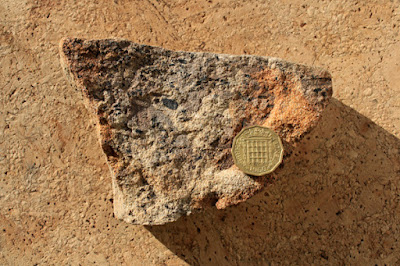My guided tour of Ranmoor by Gerald Eveleigh of the Ranmoor Society, in the last week of July 2021, added to my preparation for a talk later in the year and my first trip in August followed up a couple of visits to Wickersley, which I had undertaken the previous October.
Having seen various buildings in Brampton-en-le-Morthen, Morthen and Wickersley, which were built in both yellow/buff and red Wickersley Rock, I had shared my observations on Facebook and was informed that an old quarry face existed adjacent to Almond Glade off Morthen Road and I was given permission by the owners to visit it.
Taking the No. 19 bus from Rotherham, I found a gap in the fence along Almond Glade and tentatively made my way into the quarry, which was quite thickly overgrown and had a very thick covering of leaves that had accumulated over the years, which was underlain with rock debris.
I thought that this was potentially quite hazardous and was not comfortable traversing the quarry floor – especially since I was unaccompanied – and seeing no rock faces, I obtained a couple of samples with my Estwing hammer and retraced my steps to Almond Glade.
Whilst in the area, I had decided to also visit the village of Bramley, where there were four listed buildings that did not yet have a photograph on the British Listed Buildings website. The first on my list was The Warren (1785), an old Wesleyan Methodist Chapel that is now a house.
I didn’t get close enough to examine the sandstone from which it is built very closely, however, its yellow/buff colour, with some pink/red colouration is very similar to that seen in the various historic buildings in Wickersley and very probably came from one of the large concentration of quarries to the west of Morthen Road, which have now been infilled.
On the opposite side of Main Street is the late C17 Warren House, which was altered in the late C18 and is built with a T-shaped plan. It is built in a similar sandstone but, without any particularly interesting features to look at, I just took a few general record photographs and walked a little further down the road to the mid C18 Stonecroft, a former row of cottages that is now one house.
Continuing down to Flanderwell Lane, I could only get glimpses of the mid C18 No. 12 from the footpath, where I could see that it has a red pantile roof with stone slates to the eaves, but I just took a couple of record photos.
Walking downthe west side of Brook Lane, I was unable get a photo of the rear of No. 12 Flanderwell Lane, but I did notice that a road cutting is excavated into the northern escarpment of the plateau of Wickersley Rock, upon which Bramley and Wickersley are built.
Looking down Brook Lane from the path on the west side of the road, beneath the ivy that covers much of the opposite embankment, I could see sections of sandstone blocks and slabs that form a low retaining wall.
Taking a closer look, I could see that this is actually built on an outcrop of flaggy cross-bedded light brown coloured Wickersley Rock. Continuing down the hill the outcrop increases in height and eventually exposes a series of flaggy beds that are underlain by massive sandstone.
I obtained a few small samples from both the flaggy beds and underlying massive beds. The flaggy sandstone is fine grained and quite homogenous in colour and texture, but the massive sandstone is medium grained, with abundant carbonaceous material on the bedding planes and pronounced iron banding in the body of the rock.













No comments:
Post a Comment